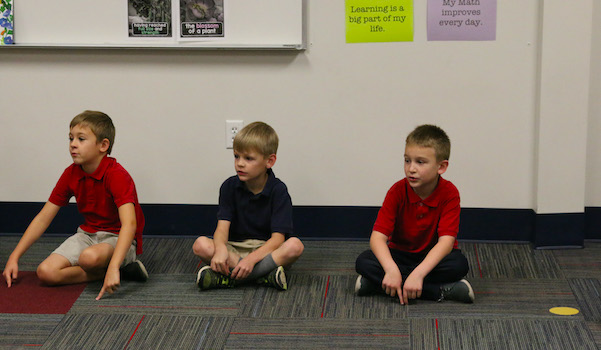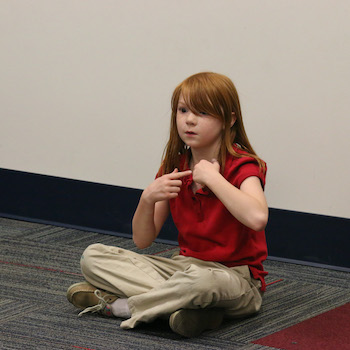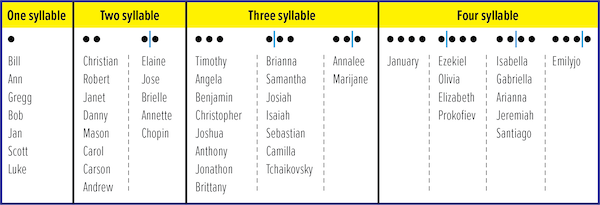SUBJECTS
GRADE
Show Results
Hickety Tickety

Lesson Summary
- Sing the song "Hickety Tickety"
- Determine syllabic stress patterns in names
- Categorize names
Lesson Plan and Procedure
Lesson Key Facts
- Grade(s): K, 1, 2, 3
- Subject(s): English Language Arts, Music, Social Studies
- Duration of lesson: 30 minutes
- Author(s):
Learning Hickety Tickety
Invite students to sit in a circle. Sing the song “Hickety Tickety” while tapping hands on the floor from left to right in front of knees to keep the beat. When singing “will you,” gesture with an upturned hand, inviting one student to say his or her name.
Teacher: Listen carefully so you repeat [the student’s] name the exact same way as he said his own name.
Sing the student’s name with the same inflection and articulation the student used.
Have a quick discussion about saying another’s name in a different way than that person says his or her own name. As an example, say a student’s name with the wrong pronunciation.
Teacher: How does it makes you feel when I say your name incorrectly?
Discuss how this singing game demonstrates respect for each individual by listening to and honoring how each person pronounces his or her own name.
 Teacher: We are going to add one more thing we need to listen to in this game. After we all repeat a student’s name, copying the pronunciation as closely as we can, I will clap the stress pattern of the name. Please do not to clap with me, but instead, listen as I clap and then figure out how many syllables the name has.
Teacher: We are going to add one more thing we need to listen to in this game. After we all repeat a student’s name, copying the pronunciation as closely as we can, I will clap the stress pattern of the name. Please do not to clap with me, but instead, listen as I clap and then figure out how many syllables the name has.
When clapping, be sure to emphasize the strong/weak stress pattern of the name. For example, “Johnny” begins with a strong sound and ends with a lighter sound- JOHN-ny. “Elaine” begins with a lighter sound (anacrusis) and ends with a strong sound- e-LAINE.
Start the singing game again, gesturing to the same individual selected the first time. Continue around the circle, encouraging students to listen to each class member says their name. The entire class then repeats the name with as close a pronunciation as possible to the individual’s own pronunciation. After each name, clap the stress pattern while the students count the number of syllables in the name and notice the strong/weak stress pattern.
Categorizing Names while Reviewing and Internalizing the Song
Repeat the process of singing the song and having students say their names. As names are said, write each name or place name cards on a chart. Names with the same stress-pattern go in the same column. Young students can quickly learn to hear syllables and stress patterns when guided to do so. This will prepare them for additional language study later on. Consider keeping the charts up all year and add other words such as vocabulary words or names of composers and visual artists.
How Many Syllables?

Additional Connections
Using this music in the classroom has many spoken and unspoken connections that impact student learning both musically and developmentally. See the document "What's Happening While Experiencing 'Hickety Tickety'" in the Additional Resources section for further information.
Learning Objectives
- Sing “Hickety Tickety” in tune
- Show the beat by moving hands back and forth while singing
- Count and segment syllables in names
- Demonstrate respect for each individual by listening to and honoring how they pronounce their own name
Utah State Board of Education Standards
This lesson can be used to meet standards in many grades and subject areas. We will highlight one grade’s standards to give an example of application.
Kindergarten Music
- Standard K.M.P.3: Develop these skills and concepts essential to music performance:
- Sing a variety of simple songs in tune.
- Perform steady beat with body percussion or un-pitched percussion.
- Standard K.M.R.1: Listen to and interact with a variety of contrasting music while recognizing steady beat, repeating patterns, and expressive elements.
- Standard K.M.CO.2: Describe how music relates to personal and social experience.
- Standard K.M.CO.4: Explore and demonstrate learning in another content area through music.
Kindergarten Language Arts
Standard K.R.2: Demonstrate mastery of age-appropriate phonological awareness skills.
Blend and segment words at the syllable level.
Identify the initial, medial, and final sound in 2-3 phoneme words.
Pronounce, blend, and segment phonemes in 2-3 phoneme words
Kindergarten Social Studies
- Standard K.3.2: List and describe the essential qualities needed to learn and work together as friends, neighbors, and family members (for example, honesty, integrity, morality, civility, duty, honor, service, respect, obedience to law).
Equipment and Materials Needed
Additional Resources
- Teacher Resource: What's Happening While Experiencing Hickety Tickety
- This lesson can be taught prior to another lesson on the BYU ARTS Partnership website, “Chopin Prelude.”
Image References
- Image 1-2: Brenda Beyal
- Image 3: Susan Kenney

www.education.byu.edu/arts/lessons
 Download
Download